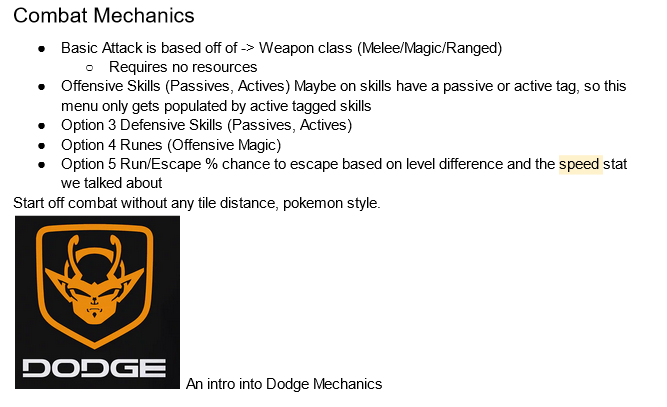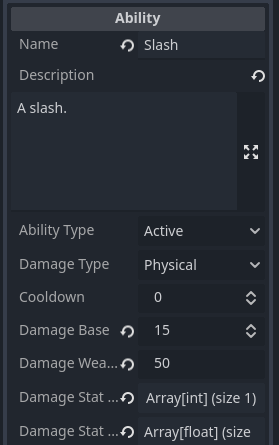Devlog 001: This is not a How To
This is not a how-to guide, but rather what happened.
Jul 30, 2024
This isn't a How-To
If you know who Adam Savage is, of Mythbuster's fame, you might have seen his Youtube channel Tested. On his channel, he documents his One Day Builds with the mindset that "this isn't a how-to guide but rather what happened." I am probably butchering that quote, but you get the point: I'm not trying to teach anyone anything; I just want to document what happened. There's also another quote by Mr.Savage: "Follow the process not the plan." This will be relevant later when we finish one system and realize we need another.
This is What Happened
We rushed in and quickly got in over our heads! That's what happened. In my haste, I started building before I knew what it was we were actually going to build. Before we knew it, I had a simple demo consisting of a player and enemy squares on a blank battlefield, attacking in a pre-determined order, hitting each other for randomized damage. "That's great!" I thought I'd created a basic turn-based game!
So I added a little bit more functionality to the battlefield. The player could now pick which enemy they wanted to hit for randomized damage. Great! I can now target enemies! But this is where progress came to a screeching halt. I now needed to add abilities the player and enemies could use.
Not knowing anything about abilities or how they would look and function was the first big roadblock we hit. This might be due to the lack of a Game Design Document.
The Game Design Document
The Game Design Document or, GDD, is basically an on-paper proof of concept that lays out a lot of what your game is, who the game is for, and how it should look, feel, and function. It starts out with a high-level concept (think of a Tweet in the pre-Elon Twitter days) and usually ends with detailed game system designs. Since I have never built anything like this before, I can no longer pull systems out of thin air. It was time to start documenting systems we agreed on. With these system designs in place, I could theoretically get to work. But first let's talk about...
Our Game Design Document

Our GDD is far from perfect. I mean, the above is the first half of the first page, and we already have memes and abandoned systems in it! But the GDD doesn't need to be perfect. We started with some game systems like abilities, leveling, and stats; then we documented how these systems would interact with each other. We can fill in gaps like setting, monetization, a name, etc., later. So Robert and I took to Discord, joined a call, and talked about a lot of the following:
- What is the Core Gameplay Loop? What keeps the player wanting to play?
- What does Leveling look like? Can you level up mid combat? What do you get from leveling?
- What do Attributes look like? Are we using basic strength, intelligence, and dexterity, or are we adding others? What do these stats do?
- How do we structure Abilities? What needs to be accounted for in an Ability? Are there passives? Can an ability hit more than one target? Do they scale off of stats or weapons?
- What do Equipment and Weapons look like? Do they offer any stats or damage buffs or nerfs?
Nothing we wrote was super in-depth. It was mostly brainstorming and writing down what we thought was "okay" for the time being. As time went on and I built more systems, we discovered that the GDD needed to be updated. Past experience was telling me, "This doesn't feel right." And my past experiences might be right. However, in the past, I've worked with domain experts who helped shape the requirements prior to work being started. Since neither Robert or I are domain experts in game development, I need to be okay with us changing the requirements under my feet.
GDD Example: Abilities
In the initial demo, I was simply randomizing damage between 1-10 for players and 1-5 for enemies on each character's turn. That doesn't lend to compelling gameplay. So, we needed to sit down and discuss how an ability system would work. We needed to go over how damage functioned, what type of damage it did (planning ahead!), and what cooldowns looked like, if any at all. We gave abilities placeholder names for the time being, and our first and most basic ability looked something like:
-
Slash: Slashes an enemy for (x wep) + (% str mod)
- Cooldown: 0
- Damage Type: Physical
- Base DMG: 15
- % Weapon DMG: 25%
- % Strength Modifier: 25%
Okay, great! Now that I have the basic structure of an ability, I can build a system around it! The Ability.gd class extends Godot's Resource class. This allows us to build the structure of the class and then save the data in a structured manner. Think JSON, but exclusive to Godot.
Below is how the Ability.gd class started. I extracted the values from the GDD, like cooldown, base damage, and weapon damage percent, and turned them into structured data the game can understand.

extends Resource
class_name Ability
@export var name: String
@export_multiline var description: String
@export_enum("Physical", "Magical") var damage_type: int
@export_enum("Active", "Passive") var ability_type: int
@export var cooldown: int = 0
@export var damage_base: int = 10
@export var damage_weap_modifier: float
@export_enum("Physical", "Magical") var damage_stat_type: int
@export var damage_stat_modifer: Array[float]
With the data structured above, I can now start creating simple abilities to have my characters randomly pick from. But our abilities have no way of determining how much damage they can do. Let's add getAttackDamage to the Ability.gd file:
func getAttackDamage() -> int:
var base: int = self.damage_base
var statMod: float = 0
var weapMod: float = 0
var idx: int = 0
for key in self.damage_stat_type:
var dmgStat: String = key.to_upper()
# Stats aren't implemented so we'll give everyone a base of 10
# regardless of what stat the ability scales off of.
var baseStat: int = 10
statMod += (baseStat * (self.damage_stat_modifier[idx] / 100))
# We don't have weapons so just throw them a bone
weapMod = ((self.damage_weap_modifier / 100) * 1.5)
return roundi(base + statMod + weapMod)
Sweet! Our ability now calculate some damage based on the data we provide. Everything is rounded to an integer out of personal preference. I prefer seeing 92 HP and not 92.4 HP.
Now, back to the Battle Scene (not shown; I'm ashamed of it), I can tie in the value returned from Ability.getAttackDamage() and tell our target to take damage! Our characters are now using a rudimentary ability system instead of simply randomizing numbers.
Final Thoughts
The keen-eyed among you might have noticed references to damage_stat_type in the ability's definition. At the moment, this is unimplemented due to the fact that characters do not yet have stats. This takes us back to the importance of a GDD. I can now reference the GDD to see if we've spec'd out how character stats work. If the stat system is documented, I can get straight to work. If it isn't, though, we start the process from scratch but this time with our new system in mind.
This might be a naive take, but I don't think the GDD will be set in stone but; instead, it can be seen as a fluid document to help ideate and iterate on decisions you and your team are making around your project.
